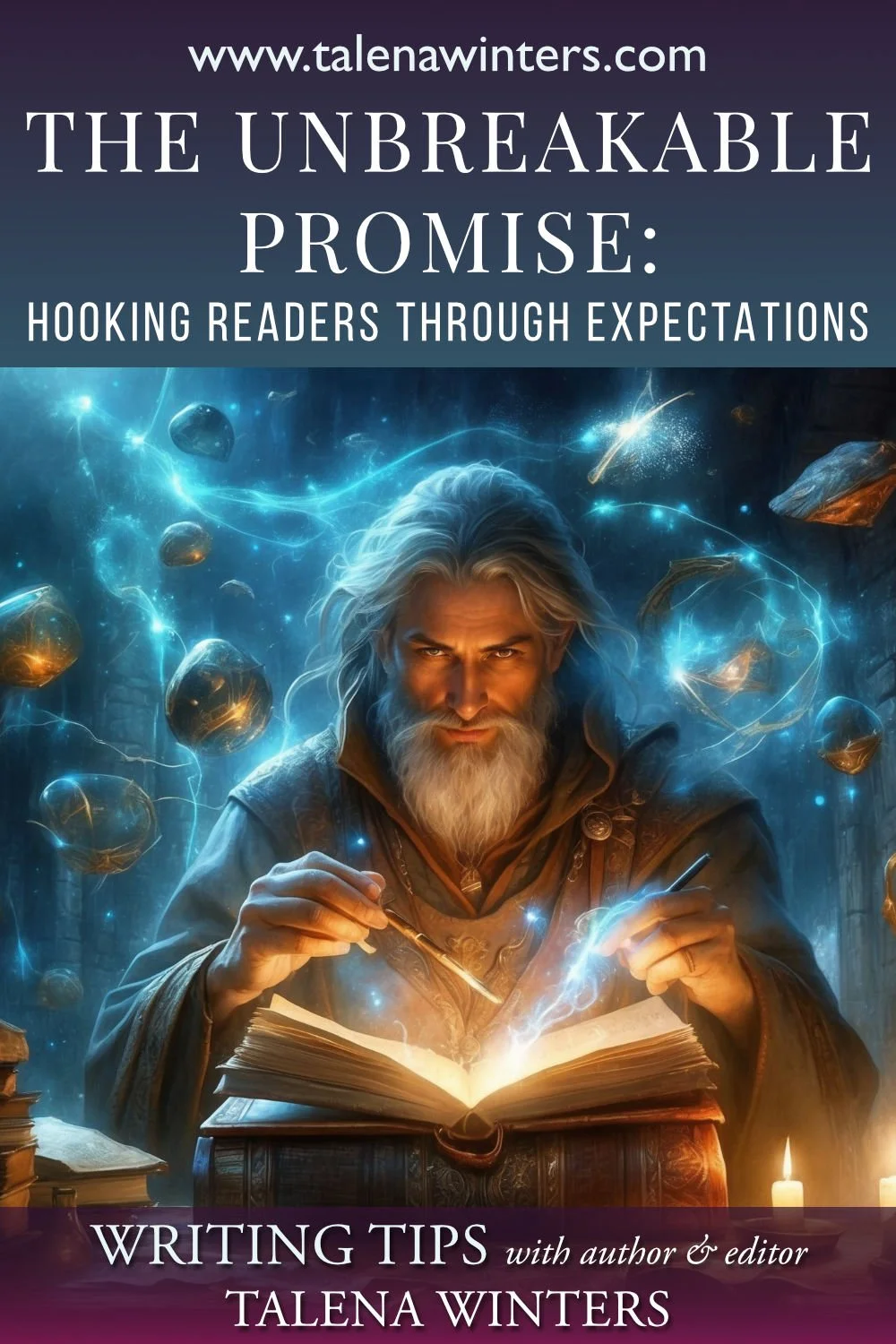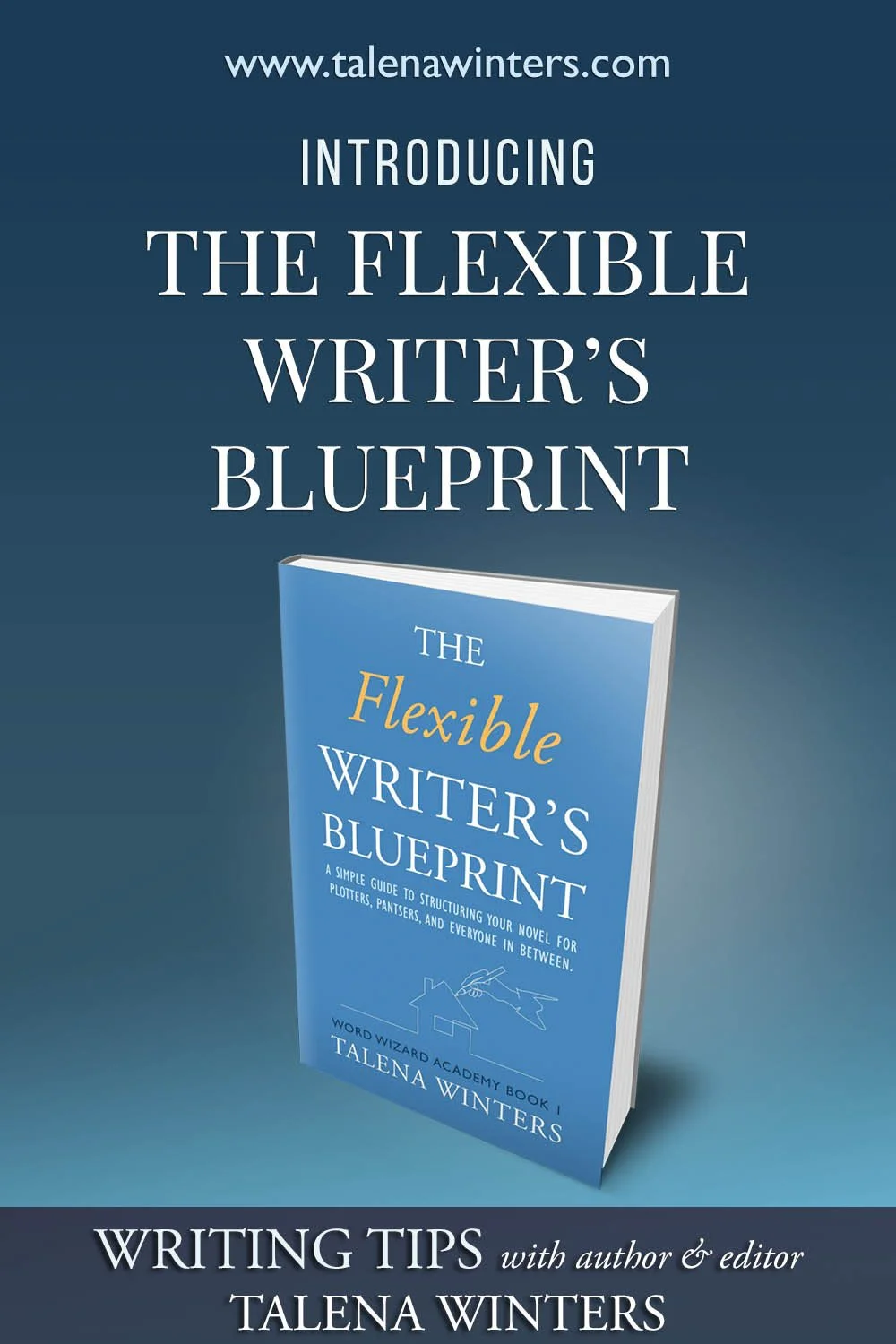The Unbreakable Promise: Hooking Readers through Expectations
Hello, word wizard!
Have you ever gotten partway through a book when something in the story leaves you with a horrible taste in your mouth? Or, worse, makes you put down (or throw) the book, never to pick it up again?
If you haven’t experienced this, lucky you. Keep reading books… you’ll find one of these eventually.
If you have, how did you feel? Unsatisfied? Betrayed? Disgusted? Disappointed?
Chances are, however you felt, the reason was the same: the writer made you a promise, and then they broke it. But when and how did they make that promise? And how can you make sure you don’t repeat this experience for readers of your books?
Today, I’m starting a new series called “Strong Beginnings”, all about giving your story a strong foundation in the first act. First acts have a big job: they have to establish world, conflicts, important characters, and more, all while hooking your reader in to read further.
In this post, we’ll explore the promises made in a compelling first act that engross your reader so completely they don’t stop reading until they get all the way to the satisfying conclusion of your story.
Are you ready for this? Have I promised something that’s hooked you into reading more?
If so… Onward!
Making Promises You Intend to Keep
The truth is, promises to the reader start before your reader even picks up your book—in the packaging and marketing and in your author brand. Though misaligned packaging can absolutely play into broken promises to your reader, that’s a different post.
For this article, I’m going to assume you managed to get your packaging correct to the point that your reader decided to give your book a shot. We’re going to focus instead on the “permissions” you establish with your readers inside your story.
“Permissions” is a term I’m borrowing from musical theatre terminology. One of the most important jobs of the big opening number of a musical play is to establish permissions—to let the audience know exactly what it’s in for. The opening number is getting permission for all kinds of things—level of humour, tone, mood, musical style, lewdness, and unusual devices the story might employ, such as puppets as characters. In other words, this is another way to say you’re establishing expectations you intend to fulfill with a satisfying payoff later.
We do the exact same thing with the opening pages of our novels.
The first act of your novel acts as an unbreakable promise to your readers. It sets expectations, establishes the world, and ignites their interest in the story to come.
Yes, it’s a tall order. Get this right, and you’ll nurture avid readers of your work. Get it wrong, and you’ll get tossed books and one-star reviews.
So let’s learn how to get it right, shall we?
The Leaning Tower of Plot: A Cautionary Tale
We’ve all heard of the Leaning Tower of Pisa. While undeniably iconic, it serves as a reminder of the consequences of a weak foundation. Built on unstable soil, the tower’s famous tilt reflects the importance of a solid base.
In storytelling, your foundation is your first act, and if it’s weak, your narrative can soon feel “off-kilter.” The lack of a solid foundation can make it difficult for readers to connect with your story, ultimately causing them to lose interest before reaching the satisfying conclusion you’ve envisioned.
A strong first act isn’t just about setting the scene—it’s about establishing the core elements that will hold your story together throughout the journey. More than that, though, ensuring you have your foundation in place allows your reader to trust you, and this trust establishes the contract between you and your reader.
This is the contract—the promise—that you should not break on pain of disappointed or angry readers, bad reviews, and plenty of reader and author heartbreak.
Am I being dramatic? Only a little. (I’m a writer, after all.)
But, I hear you asking, how do I build that foundation?
I’m so glad you asked.
In this series, I’m going to be talking all about the elements that go into creating a strong foundation for your story. In later posts, we’ll explore the following cornerstones you need to establish from page one in order to deliver a satisfying experience:
Craft a Compelling Protagonist: You want your readers emotionally invested in your narrative, and the way to do that is by putting them in the head of a character they connect with in some way. Introduce a character who is relatable and intriguing, and who possesses a clear “Lie” or internal conflict.
Build a Believable World: Create a vibrant and immersive setting that serves as a backdrop for your story and foreshadows potential challenges the protagonist will face.
Signal Genre and Tone: Give readers a clear idea of the kind of story they’re about to embark on, whether it’s a suspenseful thriller, a heartwarming coming-of-age tale, a gritty dystopian survivalist drama, a pulse-pounding steamy romance, or a fantastical adventure.
Plant the Seeds of Conflict: Introduce the central problem or obstacle your protagonist will face, sparking the reader’s curiosity and desire to see how it unfolds.
These elements are the promise you’re making to your reader that they can trust you to deliver the type of experience they’re looking for.
“These elements are the promise you’re making to your reader that they can trust you to deliver the type of experience they’re looking for.”
I can’t overemphasize how important this element of trust is.
By making sure you’ve got your foundation in place, you assure your reader that you know what you’re doing and that their questions will be answered in good time. Establishing this trust allows them to get lost in your world and go along for the ride. But if you forget to give them these subtle signals, they’ll be constantly on guard for all the ways your story is falling short in case you disappoint them in the end, and all too happy to point out those shortcomings to others later.
🤨 Honouring Your Process: Do you have to create this foundation in the first draft?
The short answer? No.
While it’s helpful to have a good handle on these important elements before you write, every single one of them can be developed more during the writing process. The important thing is that, when your story is finished (written, revised, edited, and published), your foundation is in place—whether you bolstered it during revisions or had all the pieces in place from the start.
Is it easier and more efficient to have more of this in place in the first draft?
Absolutely. But your process is your process, and there’s no wrong way of getting to a finished book. The key element is to finish it.
Every Sentence Matters: Building Trust Through Conflict
We’ve established that the first act is the foundation upon which your entire novel rests. But how exactly does this foundation build trust with your reader?
Here’s the secret: Every sentence matters. Each word you choose is a brick you lay, building not just a setting or introducing a character, but a promise to your reader.
Think of it like this: you’re inviting your reader on an adventure. They’ve packed their metaphorical bags (cleared their schedule, made a cup of tea) and are ready to embark on a journey. But before they step through the portal you’ve created (turn the first page), they need to trust you won’t lead them astray. And the light that guides their way is the conflict you pack into every sentence of your story.
Conflict: The Mortar Between the Bricks
Think of conflict as the mortar that binds the bricks (sentences) of your story together. It’s the essential ingredient that creates tension, propels the plot forward, and keeps readers hooked. Without conflict, your story becomes a flat landscape—pleasant perhaps, but ultimately forgettable. And while it should be woven into every sentence of your entire story, we need to see it right from the very first word in order to hook your reader.
Here’s the thing: conflict doesn’t have to be a dragon attack or a galactic war (though those are certainly fun!). It can be something as personal as a character’s internal struggle, a clash of ideals between family members, or the everyday anxieties of navigating a new job. The key is to identify the core conflict your protagonist faces and weave it into the very fabric of your narrative.
“Every sentence of your story should have inherent conflict.”
Every sentence of your story should have inherent conflict.
This is how you keep your reader turning those pages to see how you fulfill all those heart-pounding promises you made.
How Conflict Fuels Trust: Example in Action
Let’s imagine you’re writing a fantasy novel about a young blacksmith named Shara. In the first act, you might introduce Shara’s dream of becoming a knight, a profession traditionally reserved for nobility. This inner conflict—her aspiration versus societal expectations—creates tension and immediately sparks the reader’s curiosity.
Here’s how conflict can be woven into every sentence to build trust and engagement:
Shara slammed the hammer against the glowing metal, sweat beading on her brow. (Establishes her physical exertion and dedication. Also establishes a clear visual with action.)
The tool in her calloused fingers danced across the anvil in a practiced choreography of metal and fire. (Highlights her skill and passion, makes her sympathetic. Further grounds us in a smithy setting.)
She paused to survey her finished creation—a shining breastpiece for Sir Reginald’s armour. Holding it in front of her, she pictured herself setting off on a gallant quest with the King’s Men to keep the ravaging beasts of the Barrens away from the crops and lands of the valley. (Hints at her desire to be more than a blacksmith, also hints at the world problem).
Letting her arms drop, she shook her head. Blacksmiths don't wear shining armour, Shara. They don’t fight dragons. (Introduces the internal conflict, hinting at societal limitations.)
Her mother’s words came back to her—You can be anything you want, my girl. Your birthright doesn’t need to determine your destiny. (Shows her determination despite the obstacles and her tendency to hold on to hope.)
See how these sentences, while seemingly simple, all contribute to building trust with the reader? They establish conflict, showcase Shara’s character, and hint at the challenges she’ll face, all while showing all this to us through her actions and a defined setting. They also show that traditional gender roles aren’t likely going to be much of a problem in this world, since Shara’s already doing a traditionally male job—blacksmithing. (Though you could incorporate a gender role conflict in the next paragraph easily enough.)
This trust allows the reader to relax and invest in Shara’s journey, eager to see how she navigates her inner turmoil and societal pressures.
Remember: Don’t be afraid to let conflict simmer beneath the surface in the first act. Plant the seeds, introduce the tension, and leave the reader wanting more. By doing so, you’ll be well on your way to building a strong foundation of trust that will carry your story through to the very last page.
A Promise Fulfilled
Remember, each sentence is a promise to your reader. You’re promising them a story with conflict, a story that will evoke emotions, and a story that adheres to the conventions of a specific genre. Your first act is where you lay the groundwork for fulfilling those promises. By carefully “laying the bricks,” you create a solid foundation that supports the weight of your entire novel. This foundation entices readers to keep turning the pages, eager to discover the world you’ve built and the challenges that await your characters.
So, as you craft your first act, ask yourself: Does every sentence contribute to the central conflict? Does it evoke emotion, establish tone, and hint at the genre? By weaving these elements together, you build trust with your reader, assuring them that they’re in for a story that will keep them turning pages long after the first chapter ends.
P.S. Don’t worry, we’ll dive deeper into each of these elements—conflict, emotion, tone, and genre—in future posts. But for now, remember, conflict is the king (or queen!) in the first act. Make sure it has a prominent throne!
What are your biggest struggles at the beginning of your story?
Do you find it easy or difficult to incorporate all the elements you need to remember into your first act? Which aspect do you struggle with most?
Let me know in the comments, and I’ll be sure to address that issue later in the series.
Now, word wizard, go make some story magic!









In this first post in the “Strong Beginnings” series, we’ll explore the promises made in a compelling first act that engross your reader so completely they don’t stop reading until they get all the way to the satisfying conclusion of your story.